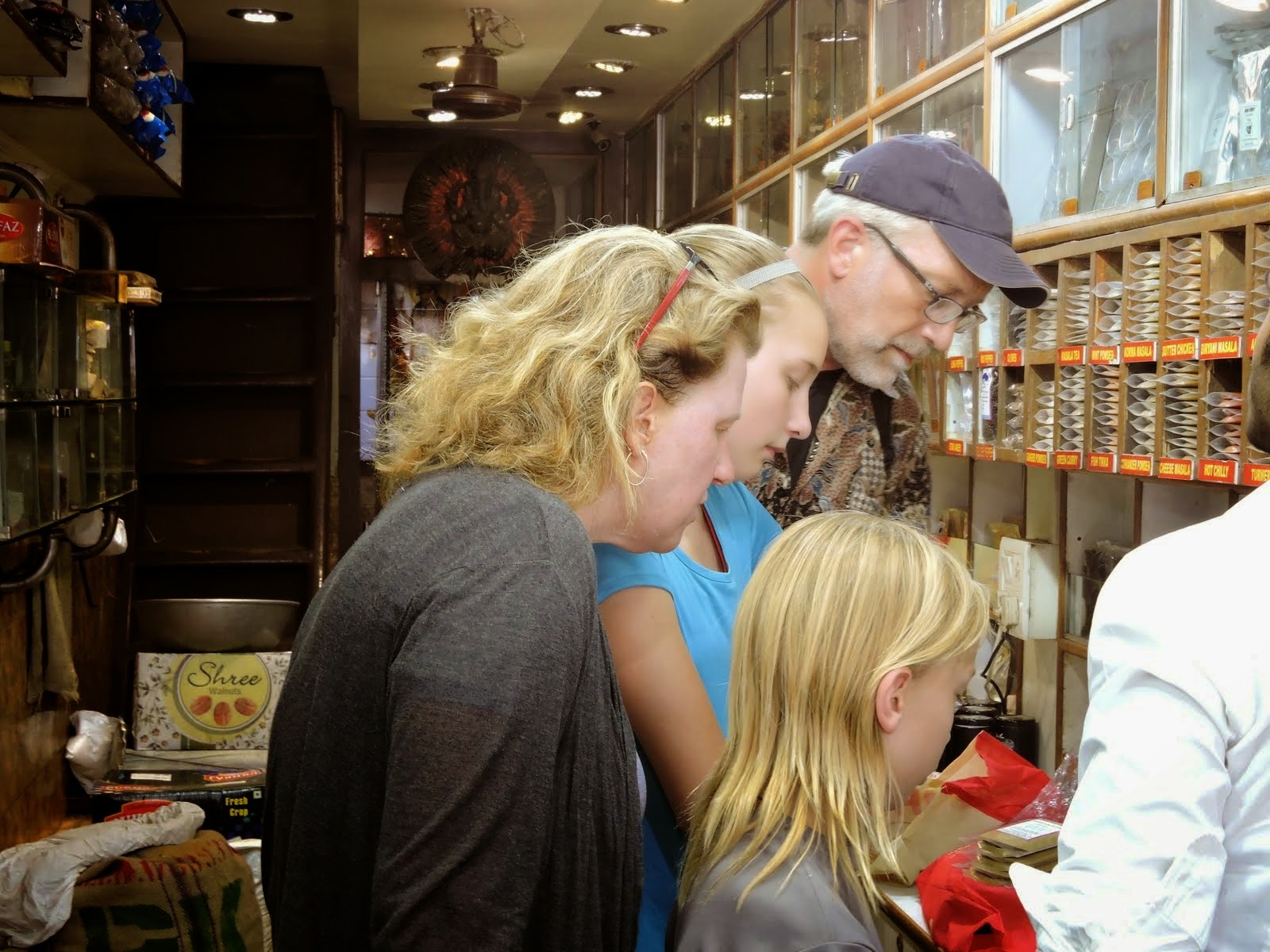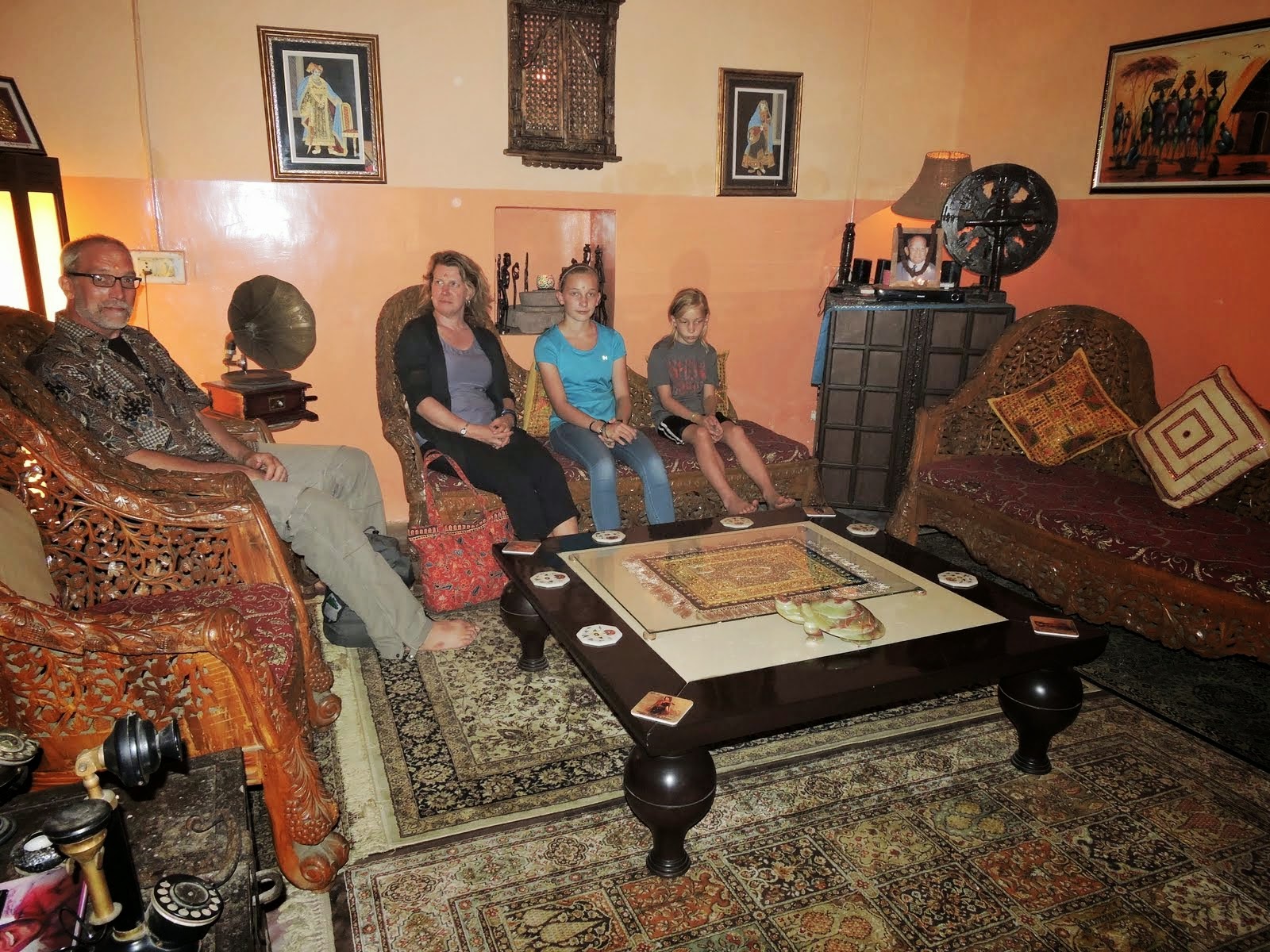This post seems to have been removed from the blog so I am reposting it. I was a little delirious at the time so I'm not sure why some of the photos were selected. I've tried to add captions.
Before this trip I had read and heard a lot about India. I thought I was prepared, but I was wrong. India has been a sensory overload. The combination of heat, sights, smells, noise, filth, poverty, air pollution and traffic are overwhelming.
Our direct flight from Singapore to Delhi was replaced with a flight stopping in Chennai (formerly Madras and the 4th largest city in India). We had to check through customs and get to our domestic flight in the next terminal by going outside and walking down the road, through a construction site, with very minimal signage. This required showing our boarding passes at eleven places, usually to 2 and 3 men. The man watching the x-ray scanner was completely asleep. The girls have to go through the walled-off "Female Frisking" area.
On arrival in Delhi, the first thing to notice is the brown haze the plane is descending through. Traffic in Delhi makes Thai traffic seem like some kind of Zen orchestrated dance. We were in 3 minor collisions that I was aware of. The honking is incessant. There are pedestrians, 2- and 4-wheeled hand carts, bicycles, bicycle rickshaws, tuk tuks, cars, big and small lorries, buses, bull (ox) carts, donkey carts and horses all sharing the same travel space. A taxi driver told us that to drive in Delhi you need three things, a good horn, good brakes and good luck. Honking was apparently outlawed last year and it is now quieter. I can't imagine it.
It's been a challenge, Zoe was sick in Singapore before getting on the plane and again on our second flight. Jack passed out, hitting his head on a table in the hotel lobby (they have both recovered) and I'm in my second day without eating due to illness.
Two weeks before we arrived, the government quit licensing cars over 10 years old to reduce air pollution. The air quality index was 250 (very unhealthy) on the PM2.5 scale. It hurt to breath.
Poverty is everywhere. The UN says more than 1.1 million people in Delhi live in extreme poverty.(roughly less than $1 per day. The poor work the intersections begging by scratching and tapping on windows. People sleep under parked cars to avoid the heat and being kicked. Groups of small children (2 to 4 years old) reside in the Metro stations. A person I saw get tripped over on the street I was afraid was dead until his eyelids twitched.
We are staying in Old Delhi. The first night we ordered room service and didn't leave our room. We gave some consideration to moving to a Holiday Inn. The next morning I ventured out and arranged for a cab to drive us around while we are here and then drive us to Agra at the end of the week. The first day we visited the Red Fort completed in 1648 by Shah Jahan, the Mughal empower that moved his capital to Delhi in 1639. A mile and a half of the red sandstone walls (60 to 105 feet high) surrounding 250 acres remain. The fort was inside of the 1500 acre walled city of Old Delhi. We also visited the Mahatma Gandhi memorial park and Humayun's Tomb (another Mughal emperor). Afterward, I went on a several mile walk on my own. The area I was in was the hardware district with streets so narrow very few motor vehicles entered in mostly hand trucks and rickshaws.
We are a novelty in India. The blonde kids, especially Zoe attract attention. I'm the tallest person I've seen. Several people have told me so. Dozens of people have had their picture taken with us.
The second day we went on a guided walking tour of Old Delhi. We went places we would have never gone on our own like unlit narrow alleys, a Hindu temple where we were blessed, roof tops and a private haveli (home) for lunch. W also went to the largest spice market in India. I don't know what it was, but in one alley everyone, not just us, we're coughing and sneezing.
We've seen rats, cats, monkeys, lots of dogs and cows, donkeys and horses in the streets of Delhi.
Water in Delhi flows 1 to 1-1/2 hours per day. Every building has a cistern to store water.
Red Fort palace
Old Delhi from a roof top.
Ann-Kristin and a bull cart
A bull
Nut sales
Ann-Kristin and Jack on a rickshaw
A spring making shop
Us in an alley
At the door of an old haveli (mansion)
Another rickshaw
Us in the streets of Old Delhi
Ready to get back to the hotel
A roof top balcony
Bangle shop
Before this trip I had read and heard a lot about India. I thought I was prepared, but I was wrong. India has been a sensory overload. The combination of heat, sights, smells, noise, filth, poverty, air pollution and traffic are overwhelming.
Our direct flight from Singapore to Delhi was replaced with a flight stopping in Chennai (formerly Madras and the 4th largest city in India). We had to check through customs and get to our domestic flight in the next terminal by going outside and walking down the road, through a construction site, with very minimal signage. This required showing our boarding passes at eleven places, usually to 2 and 3 men. The man watching the x-ray scanner was completely asleep. The girls have to go through the walled-off "Female Frisking" area.
On arrival in Delhi, the first thing to notice is the brown haze the plane is descending through. Traffic in Delhi makes Thai traffic seem like some kind of Zen orchestrated dance. We were in 3 minor collisions that I was aware of. The honking is incessant. There are pedestrians, 2- and 4-wheeled hand carts, bicycles, bicycle rickshaws, tuk tuks, cars, big and small lorries, buses, bull (ox) carts, donkey carts and horses all sharing the same travel space. A taxi driver told us that to drive in Delhi you need three things, a good horn, good brakes and good luck. Honking was apparently outlawed last year and it is now quieter. I can't imagine it.
It's been a challenge, Zoe was sick in Singapore before getting on the plane and again on our second flight. Jack passed out, hitting his head on a table in the hotel lobby (they have both recovered) and I'm in my second day without eating due to illness.
Two weeks before we arrived, the government quit licensing cars over 10 years old to reduce air pollution. The air quality index was 250 (very unhealthy) on the PM2.5 scale. It hurt to breath.
Poverty is everywhere. The UN says more than 1.1 million people in Delhi live in extreme poverty.(roughly less than $1 per day. The poor work the intersections begging by scratching and tapping on windows. People sleep under parked cars to avoid the heat and being kicked. Groups of small children (2 to 4 years old) reside in the Metro stations. A person I saw get tripped over on the street I was afraid was dead until his eyelids twitched.
We are staying in Old Delhi. The first night we ordered room service and didn't leave our room. We gave some consideration to moving to a Holiday Inn. The next morning I ventured out and arranged for a cab to drive us around while we are here and then drive us to Agra at the end of the week. The first day we visited the Red Fort completed in 1648 by Shah Jahan, the Mughal empower that moved his capital to Delhi in 1639. A mile and a half of the red sandstone walls (60 to 105 feet high) surrounding 250 acres remain. The fort was inside of the 1500 acre walled city of Old Delhi. We also visited the Mahatma Gandhi memorial park and Humayun's Tomb (another Mughal emperor). Afterward, I went on a several mile walk on my own. The area I was in was the hardware district with streets so narrow very few motor vehicles entered in mostly hand trucks and rickshaws.
We are a novelty in India. The blonde kids, especially Zoe attract attention. I'm the tallest person I've seen. Several people have told me so. Dozens of people have had their picture taken with us.
The second day we went on a guided walking tour of Old Delhi. We went places we would have never gone on our own like unlit narrow alleys, a Hindu temple where we were blessed, roof tops and a private haveli (home) for lunch. W also went to the largest spice market in India. I don't know what it was, but in one alley everyone, not just us, we're coughing and sneezing.
We've seen rats, cats, monkeys, lots of dogs and cows, donkeys and horses in the streets of Delhi.
Water in Delhi flows 1 to 1-1/2 hours per day. Every building has a cistern to store water.
Red Fort palace
Red Fort palace
Red Fort walls
Old Delhi
Old Delhi from a roof top.
Old Delhi street
Ann-Kristin and a bull cart
A bull
Betel leaves and nuts - People chew these all day as a stimulant. There are red stains everywhere from the spit (especially on buses below windows)
Nut sales
Old Delhi view from roof top
Old Delhi view from roof top
Old Delhi view from roof top
Old Delhi view from roof top
Spice market
Spice market
Ann-Kristin and Jack on a rickshaw
Ann-Kristin frying bread
A spring making shop
Us in an alley
Bars in an alley to prevent passage of donkey cart
At the door of an old haveli (mansion)
Another rickshaw
Gate to the queen's former palace (now shops)
Us in the streets of Old Delhi
Ready to get back to the hotel
Another bull cart
A roof top balcony
In a restored haveli (mansion)
In a restored haveli (mansion)
In a restored haveli (mansion)
Being blessed in a Hindu temple
Bangle shop
Qutb Minar
Qutb Minar







































Oh, the honking thing: in India drivers traditionally honk to let other drivers know they are there, like echolocation. We noticed even on the empty highway our driver would honk when another car appeared over the hill. I can see why Delhi would be trying to change this habit!
ReplyDeleteWhen I was in Mumbai, I felt like every traffic stop was a race. All the methods of mobility would squeeze to the front of the line and when the light turned green they would try to get out front with much honking and waving. My friend I was staying with told me they drive like maniacs but if they hit a pedestrian the driver will get mobbed and beaten up. The country was not much better because the roads were narrow and truck drivers would barrel down them and not care if they ran you off the road. No barriers on hill sides. And every day vehicles would roll over. I think what got me most was the blatant disregard for human life. That and the garbage. Two weeks and I was ready to come home, and I was staying with a very well off family so assume I was protected from the worst. And, I would go back, so much to see, it's a huge country. Plus it totally changed my perception of the world.
ReplyDelete